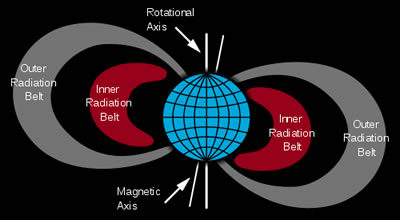Cosmic rays consist of atomic nuclei that expelled by stars, including our Sun.
The Earth is often bombarded with cosmic rays from huge radiation storms.
Most of these rays are blocked by the Earth's atmosphere. However, some of the most powerful rays are able to penetrate the atmosphere and reach all the way to sea level.
If more of this radiation reached the surface, life on Earth as we know it today could not survive.
The majority of the cosmic rays that reach Earth's atmosphere are the nuclei of hydrogen atoms. However, nuclei of heavier elements are also among the rays reaching Earth
Cosmic rays traveling through space at speeds close to that of light - 186,000 miles per second. They carry huge amounts of energy.
When they collide with the gas molecules of the upper atmosphere, they trigger secondary cosmic showers, which consist of the debris of these collisions.
Van Allen Radiation Belts
 James Van Allen was an American physicist who worked on the design and construction of miniaturized instruments for the US Navy during World War II.
James Van Allen was an American physicist who worked on the design and construction of miniaturized instruments for the US Navy during World War II.
After the war, he began working on rockets and studying conditions at high altitudes.
In 1956, Van Allen edited a book entitled The Scientific Uses of Earth Satellites. He worked on developing tiny instruments that could be crammed into satellites so that they could be used for scientific research in space.
When Explorer 1, the United States' first Earth satellite, was launched on February 1, 1958, Van Allen placed a single Geiger counter tube on board. It was about the size of a small cigar. Batteries supplied voltage to the tube, and a tiny amplifier magnified the electrical pulses produced by the Geiger counter whenever electrically charged particles, such as cosmic rays, passed through it.
Below the orbiting spacecraft, a global network of receiving stations, scattered around the world, was set up to receive radio signals as it swung overhead.
Sixteen such receiving centers were scattered around the world.
Explorer 1 followed an elliptical path around the Earth. Its closest approach to the planet's surface was 224 miles above sea level. The most distant point in its orbit lay 1573 miles out in space.
The first of the satellite's transmissions were reported by stations within the United States above which Explorer 1 descended closest to the Earth. They indicated cosmic rays in numbers that agreed fairly well with estimates made from earlier rocket experiments.
A few weeks after Explorer 1 had been launched, reports began to stream in from tracking stations all over the world: Australia, Singapore, Nigeria, Chile. On the side of the globe opposite North America, Explorer 1 had climbed to its highest altitude-higher than either of Russia's earlier satellites, Sputniks 1 and 2, had gone.
When Van Allen and his colleagues collected and analyzed the data, they discovered that at very high altitudes the Geiger counter recorded no cosmic rays at all.
It seemed unlikely that the instruments were malfunctioning, because they continued to work perfectly at lower altitudes. Scientists also found it very hard to believe that there were no cosmic rays at the farther limits of Explorer 1's orbit.
However, there was a third explanation - something far out in space was causing the Geiger counter to stop functioning when it reached very high altitudes. As soon as it returned to lower altitudes, it started working again.
The scientists hypothesized that at high altitudes, the counter ran into a swarm of cosmic rays that was so intense that it could not handle it and, therefore, stopped working.
Van Allen subjected a duplicate Geiger counter to a powerful beam of X-rays in his laboratory, and confirmed that it went dead when it was overloaded.
He concluded that the Geiger counter in Explorer I must have been bombarded with many times the number of cosmic rays that struck it closer to Earth.
This led to the discovery of a great zone of radiation encircling the Earth.
This zone was named the Van Allen Radiation Belt. It surrounds the Earth like a slightly flattened inner tube. Beginning roughly 500 miles above the Earth's surface, this zone - about 1000 miles in width - extends far out into space.
Not long after the Explorer 1 mission, an American spacecraft was aimed at the Moon but never got there. It crashed back to Earth instead. Although it did not achieve its mission, it did reach far enough into space to relay news that there was a second Van Allen Belt around the Earth.
This second belt begins about 12,000 miles out, increases steadily in intensity for several thousand miles and then gradually tapers off-reaching more than 50,000 miles from Earth.
Later space probes revealed that the heart of this second belt has a crescent shape with the crescent's tips, or cusps, pointing inward toward the Earth's magnetic poles.